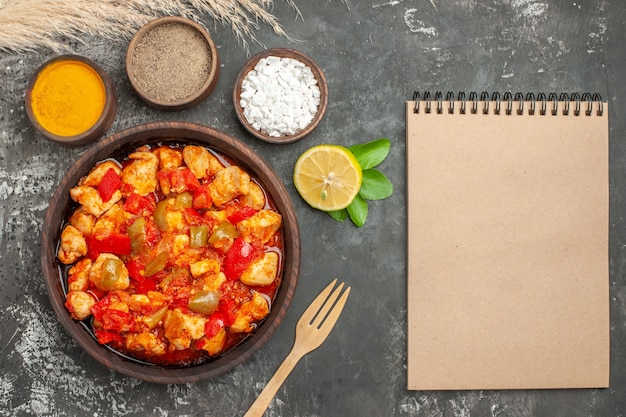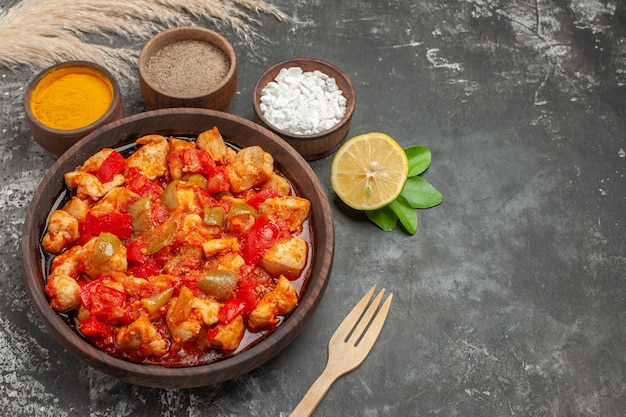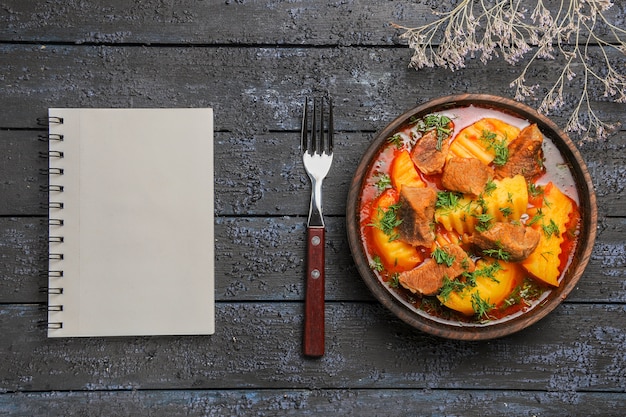(Part 1) Understanding the Foundations

What is Kare Kare?
Kare kare is a Filipino stew that's all about the peanut sauce. This thick, creamy base is the heart and soul of the dish, giving it its unique flavour and texture. It's typically made with roasted peanuts, ground into a paste and simmered in a rich broth. Traditionally, oxtail is used as the main meat, but you can also use beef shank, tripe, or even chicken for a lighter option.
Now, here’s the thing, the flavour of kare kare is much more than just peanuts. It’s a symphony of contrasting flavours. The nutty richness of the peanut sauce is balanced by the earthy notes of the vegetables, the tartness of the shrimp paste (bagoong alamang), and the savoury depth of the meat. It's a beautiful dance of taste and texture, a complex harmony that makes this dish so addictive.
A Dish Steeped in History
Kare kare has a rich history, dating back to the pre-colonial period of the Philippines. It was originally made with rice flour and pounded peanuts, but over time, the recipe evolved to include other ingredients like vegetables and meat.
While the exact origins of kare kare are a bit of a mystery, it’s believed to be a reflection of the Philippines' diverse culinary influences. The dish likely originated from the indigenous people of the country, who would have used peanuts and other local ingredients to create hearty stews.
Key Ingredients
To make the best kare kare, you need to start with the right ingredients. These are the essentials:
- Roasted Peanuts: These are the heart and soul of the dish. Absolutely no shortcuts here – you need the real deal, roasted peanuts, preferably unsalted. This is what gives the sauce its depth of flavour.
- Oxtail or Other Meaty Cuts: Provides the depth of flavour and a rich, meaty texture. Oxtail is a classic choice, but you can also use beef shank, tripe, or even chicken if you prefer.
- Vegetables: These are the stars of the show. Traditionally, you'll find eggplant, string beans, bok choy, and taro (gabi) in kare kare. Each vegetable adds its unique flavour and texture. But don't be afraid to get creative and add your own favourites, like green beans, spinach, or even mushrooms.
- Shrimp Paste (Bagoong Alamang): The secret weapon that adds a pungent, salty, and umami punch to the dish. It’s a crucial element in bringing out the best flavours in the stew. Be careful though, a little goes a long way.
- Fish Sauce (Patis): Adds another layer of savoury depth and balances the sweetness of the peanut sauce. Don't use too much, just a teaspoon or two should do the trick.
- Broth: The foundation for the sauce. You can use chicken stock, beef broth, or even water. I like to use a combination of water and chicken stock for a lighter flavour.
(Part 2) Mastering the Peanut Sauce

Roasting the Peanuts
This is where the journey to delicious kare kare really begins. Roasting your own peanuts gives the sauce a much deeper flavour than using pre-roasted ones. You'll want to find high-quality peanuts, and don't be afraid to go for a whole batch—you’ll want plenty of peanuts for the sauce and for snacking.
- Preheat your oven: Set your oven to 350°F (175°C).
- Spread the peanuts: Line a baking sheet with parchment paper and spread the peanuts in a single layer. Make sure they have space to breathe and roast evenly.
- Roast until fragrant: Roast for about 15-20 minutes, or until the peanuts are fragrant and golden brown. Keep a close eye on them to make sure they don't burn.
- Cool completely: Once they're out of the oven, let the peanuts cool completely before using them. This allows them to become crisp and release their full flavour.
Blending the Peanut Sauce
Now, for the magic! You're going to blend those roasted peanuts into a smooth, creamy sauce.
- Grind the peanuts: I prefer to use a food processor for this, but a blender works too. Pulse the roasted peanuts until they're finely ground. You want a smooth paste, but don't over-process or you'll end up with peanut butter.
- Add the broth: Slowly add the broth, a little at a time, while blending. This will help create a smooth, creamy sauce.
- Season to taste: Add a pinch of salt and a little sugar to balance the flavours. I also like to add a tablespoon of fish sauce to give the sauce an extra savoury punch.
Simmering the Sauce
This is where the magic really happens! Now it's time to let the sauce simmer and meld the flavours.
- Transfer to a pot: Pour the blended peanut sauce into a large pot. I prefer to use a dutch oven for this, as it can handle the heat and retain the warmth of the stew.
- Simmer gently: Bring the sauce to a simmer and cook for about 15-20 minutes, stirring occasionally. This will allow the flavours to develop and the sauce to thicken slightly.
- Adjust the consistency: If the sauce is too thick, you can add a bit more broth. If it's too thin, you can simmer it for a bit longer. You want it to be thick and creamy, but not so thick that it's difficult to stir.
(Part 3) Preparing the Meat and Vegetables

Meat Preparation
The meat is an important part of kare kare. Here’s how to get it ready.
- Cut the oxtail into pieces: I like to cut the oxtail into 2-3 inch pieces. This makes it easier to eat and to cook evenly.
- Sear the oxtail: Heat some oil in a large pot or Dutch oven over medium-high heat. Sear the oxtail pieces on all sides until they're nicely browned. This will add a rich flavour to the stew.
- Add to the sauce: Transfer the seared oxtail to the pot with the peanut sauce.
Vegetable Preparation
Now let's get those vegetables ready to add to the stew.
- Prepare the eggplant: Cut the eggplant into 1-inch cubes and salt them lightly. This will help to draw out some of the bitterness. Rinse the salt off after about 30 minutes.
- Prepare the string beans: Trim the ends of the string beans and cut them into 2-inch pieces.
- Prepare the bok choy: Separate the bok choy leaves and wash them thoroughly.
- Prepare the taro: Peel the taro and cut it into 1-inch cubes. If you're using fresh taro, be sure to soak it in water for about 30 minutes before cooking to remove any excess starch.
(Part 4) The Art of Assembling and Cooking
Adding the Vegetables and Shrimp Paste
Now, we're about to bring the stew together.
- Add the vegetables: Add the eggplant, string beans, bok choy, and taro to the pot with the oxtail and peanut sauce.
- Add the shrimp paste: Add a teaspoon or two of shrimp paste to the pot. Remember, a little goes a long way, and you can always add more later if you want.
Simmering to Perfection
Now it’s all about cooking slowly to allow the flavours to develop.
- Bring to a simmer: Bring the stew to a simmer over medium heat.
- Cover and cook: Cover the pot and cook for about 1-2 hours, or until the oxtail is tender and the vegetables are cooked through.
- Stir occasionally: Stir the stew occasionally to make sure the vegetables don't stick to the bottom of the pot.
- Adjust seasonings: Taste the stew and adjust the seasonings as needed. You may need to add more salt, fish sauce, or sugar to balance the flavours.
(Part 5) Finishing Touches and Serving
Garnishing and Serving
Now, we’re ready to bring this to the table.
- Add some crunch: I like to add a handful of toasted peanuts on top of the kare kare for a bit of crunch. This provides a textural contrast to the creamy sauce and adds a nutty flavour.
- Serve with rice: Kare kare is traditionally served with steamed rice. I prefer to use jasmine rice, but any type of white rice will do.
- Add a side of bagoong: Serve a small dish of shrimp paste (bagoong alamang) on the side. This allows guests to adjust the level of pungency to their liking.
Optional Additions
You can experiment with different additions to the stew. Here are a few ideas to make your kare kare even more delicious:
- Green chillies: For a bit of heat, add a few green chillies to the stew.
- Lemongrass: A sprig of lemongrass adds a citrusy aroma to the dish.
- Ginger: A little ginger can add a warm, spicy flavour to the stew.
- Garlic: A few cloves of garlic can add a strong, pungent flavour to the stew.
(Part 6) Kare Kare Variations
Chicken Kare Kare
You can easily make chicken kare kare by simply substituting the oxtail with chicken. Use chicken thighs or legs for the best flavour. Cook the chicken until it's tender and shred it before serving.
Vegetarian Kare Kare
For a vegetarian version of kare kare, you can use firm tofu, seitan, or jackfruit. Simply cook the chosen ingredient until it’s heated through and add it to the stew during the last 30 minutes of cooking.
(Part 7) Tips and Tricks
Using Pre-Roasted Peanuts
If you can't find unsalted roasted peanuts, you can use pre-roasted salted peanuts. Just be sure to rinse them thoroughly to remove excess salt. This will help to reduce the saltiness of the peanut sauce.
Making the Sauce Ahead
You can make the peanut sauce up to a day in advance and store it in the refrigerator. Reheat it gently before adding the meat and vegetables. This can be a great time-saving tip for busy weeknights.
Thickening the Sauce
If the sauce is too thin, you can thicken it by adding a tablespoon of cornstarch mixed with a little water. Simply stir it into the sauce and simmer for a few minutes, until the sauce has thickened to your liking.
(Part 8) FAQs
What is bagoong alamang, and where can I find it?
Bagoong alamang is a shrimp paste made from fermented shrimp. It's a staple ingredient in Filipino cuisine and is widely available at Asian grocery stores. If you’re struggling to find it, you can often order it online.
Can I use peanut butter instead of roasted peanuts?
While it might seem easier, you really shouldn't. Peanut butter doesn't have the same flavour and texture as roasted peanuts. It will create a sauce that’s too smooth and lacks the richness and depth of the traditional version.
What if I don't like shrimp paste?
Don't worry! If you don't like shrimp paste, you can omit it completely. However, it adds a unique flavour that many find essential to the dish. As an alternative, you can try a small amount of fish sauce for a similar savoury punch.
Can I use any kind of broth?
While you can use chicken broth or beef broth, I recommend using a combination of water and chicken stock for a lighter flavour. You can also use vegetable broth if you prefer.
How can I make kare kare vegan?
To make kare kare vegan, simply omit the shrimp paste and use a plant-based broth. You can also use vegan alternatives to the traditional meat like seitan or jackfruit.
(Part 9) My Kare Kare Journey
Making kare kare is a labour of love. It's about embracing the nuances, understanding the flavours, and appreciating the history behind this delicious dish. I’ve spent years perfecting my recipe, trying different techniques and experimenting with various ingredients. And I’ve learned that the best kare kare is made with a heart full of passion and a willingness to experiment.
I’ve shared my kare kare with friends and family, and the reactions have been incredible. People always go back for seconds, and sometimes even thirds! And that’s the best reward for a cook. Knowing that you’ve created something special, something that brings joy to those you love.
So, go on, give it a try. You might be surprised at how easy it is to make delicious kare kare. And who knows, maybe you’ll discover your own unique twist on this classic Filipino dish.
Everyone is watching

Corn on the Cob: The Ultimate Guide to Perfectly Cooked Ears
Healthy MealsAh, corn on the cob. Just the name evokes images of sunny days, barbecues, and that sweet, juicy flavour that ...

Scallops: The Ultimate Guide to Perfect Cooking
Healthy MealsAh, scallops. Those delicate, sweet, and utterly delicious morsels of the sea. They hold a special place in my...

Spaghetti Squash: The Ultimate Guide to Cooking and Serving
Healthy MealsRemember that time you saw spaghetti squash at the supermarket, looking all bumpy and strange, and thought, "W...

Salmon Cooking Times: Perfect Guide for Every Recipe
Healthy MealsLet me tell you, cooking salmon is an art form. It's all about getting that perfect balance: juicy and tender,...

Ham Cooking Time: How Long to Bake, Smoke, or Boil a Delicious Ham
Healthy MealsAh, ham. It's a classic, isn't it? A real crowd-pleaser, especially around holidays. And when done right, it'...
